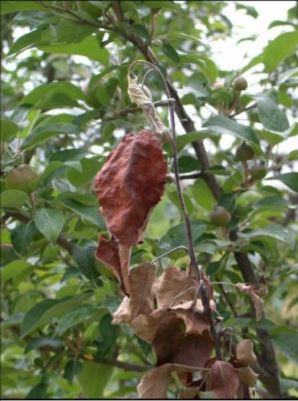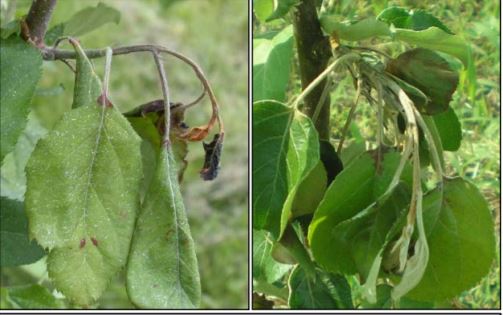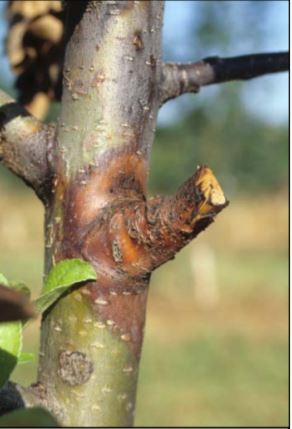Post-Bloom Fire Blight Management
This article was originally posted in Wisconsin Fruit News Volume 3, Issue 4 on June 1, 2018.
Apple bloom for 2018 is history for most of the state. Exceptions are parts of Door County, and newly planted orchard blocks that might be lagging established blocks. Wet weather during bloom in some regions and warm to hot weather in late May have set the stage for fire blight. Fire blight is caused by a bacterium, Erwinia amylovora, which makes management quite different from managing fungal diseases such as scab, rust, and powdery mildew.
The most reliable strategies for managing fire blight are 1. Use of relatively resistant cultivars and rootstocks; 2. Late winter pruning to remove infected branches; 3. Use of antibiotics during bloom to prevent infection of flowers; and 4. Reigning in shoot growth by use of Apogee and not over fertilizing trees with nitrogen. There are other options (e.g., copper applied at green tip), but the four points listed are backed up with substantial research and grower experience. The only one on that list that comes after bloom is the last point—reigning in shoot growth with Apogee and avoiding too much nitrogen. However, even though your best window for fire blight control might be past for 2018, you should be aware of the pros and cons of remaining options.

Apogee (prohexadione calcium) inhibits production of gibberellin, a plant hormone that causes shoots to elongate. Fire blight loves soft, lush, rapidly growing shoots in late May and through June. By inhibiting shoot growth, Apogee reduces shoot susceptibility to fire blight. In young trees, you don’t want to stunt growth, but in trees that have filled their space, Apogee can be a useful tool. The first application is made at the time of king bloom petal fall. It takes about 10-14 days for the inhibition of growth to take effect. Often, one application is enough to curtail fire blight development, but additional applications are permitted and might be beneficial on very vigorous trees of varieties that are highly susceptible to fire blight. See pages 28-29 of the 2018 Midwest Fruit Pest Management Guide for details on timing, rates, and precautions about what not to mix with Apogee. The guide is free online and can be found by searching that title.
Fertility. After a period of rapid shoot growth in May and June, apple trees set terminal buds in early July. At this stage, they are almost resistant to new fire blight infections. As a rule of thumb, nitrogen should not be applied after July 1. If nitrogen is applied in July, however, shoots remain soft and highly susceptible to fire blight.
Winter pruning. Removing branches with fire blight during winter pruning is essential. While it’s impossible to remove all infected tissues, you can reduce overwintering inoculum substantially and protect not only the pruned block but also any nearby young, high-value plantings. Old fire blight cankers are often colonized by fruit rot and canker fungi, so that’s another good reason to get rid of infected branches.

discoloration of shoot tips, note browning at leaf base near petiole in both photos. This indicates that the pathogen is in vascular tissue and is moving systemically.
Pruning active fire blight infections is a controversial subject, but most researchers and experienced growers agree that it’s better to prune what you can rather than do nothing, especially in young plantings and in established blocks that are near young plantings. The advantage of pruning active cankers is that you are removing large loads of Erwinia, which at least in theory, reduces the risk of disease spread. The disadvantage is that you risk spreading disease on pruning tools, and aggressive pruning can invigorate trees and make them more susceptible to fire blight. Some generally agreed upon pruning strategies for pruning out active infections:
Make cuts at least 12 inches below visible symptoms, but leave an “ugly stub” of about 4-6 inches in 2-year-old or older wood. The idea is that a small canker will form on the stub, but because older wood is not highly susceptible, the ugly stub will be a dead end for infection. Then, during winter pruning, the ugly stubs are removed by making horticulturally-correct cuts near the base of the branch union. Disinfecting tools by immersing in 10% bleach for 30 seconds or spraying with Lysol or similar products is recommended to avoid spreading Erwinia on tools. A shortcut approach to the “ugly stub” method is to break out shoots by hand. Either way, pruning should be done during dry conditions, because the pathogen is easily spread in water. Prunings can be left in the row middles to dry. After they are dry (bark no longer slips), they won’t be a source of fire blight, but prunings should be mowed so that they don’t become a reservoir for canker and fruit rot fungi.

NEWA fire blight forecasts can help predict “trauma blight” outbreaks and alert you to be looking for symptoms after a trauma event such as hail or a thunderstorm with strong winds. If you are near a weather station in the NEWA network, log onto the fire blight risk prediction page. Enter the date of the trauma event, and then the model will tell you how close you are getting to the 100 degree-day threshold for symptom appearance. Because of error in the model, I would suggest scouting for shoot blight once you reach 75 days rather than waiting for the 100-DD trigger. In valuable young plantings of susceptible cultivars, you should monitor as often as possible in late May through June, regardless of NEWA warnings.
Copper, antibiotics, and other chemicals after bloom? As a rule, use of chemicals other than Apogee after bloom is not recommended for fire blight control. Unlike most fungal diseases, fire blight is nestled within vascular tissues and therefore out of reach of chemicals. Streptomycin is locally systemic, but it does not move around much in vascular tissue. Nevertheless, some research and circumstantial evidence suggests that spraying streptomycin within 24 hours of a hailstorm or windstorm reduces fire blight spread by protecting wounded shoots. Likewise, in non-bearing plantings where we’re not concerned about fruit russet, trees can be sprayed with copper. Although there’s scant data to prove it, this should prevent trees from fire blight infection and it doubles for scab control. Kari Peter of Penn State University has tested coppers for blossom blight control and reports that NuCop XLR at 4 qt/acre is the most effective. Copper doesn’t usually injure apple leaves, but it’s best to apply it alone rather than in tank mixes that sometimes lead to plant injury. Risk of copper injury is greater at low pH, so it absolutely should not be mixed with phosphorous acid (e.g., Aliette, ProPhyt AgriFos, Phostrol).
Biocontrols, resistance inducers, and other “soft” products, such as Serenade, Double Nickel, Regalia, and Oxidate have been tested for fire blight control, mostly by spraying during bloom. These products often provide control better than the untreated check, but they usually are not as effective as spraying streptomycin during bloom. Trials in which products are applied after bloom are lacking, but knowing the systemic, fast-growing nature of Erwinia, I am not optimistic any of these products applied after bloom would work. Give each fruitlet in a cluster a number using a permanent marker. Using a consistent pattern (such as ‘1’ for the king flower, ‘2’ for the fruitlet on the north side of the cluster, and continuing around clockwise) will help if numbers wash off or become illegible.
Control potato leafhopper, as this insect has been implicated in spreading the fire blight pathogen as it feeds. Aphid outbreaks often coincide with fire blight epidemics, but this is probably because both aphids and fire blight prefer soft, rapidly growing shoots, rather than one leading to the other.
Keep calm and carry on. Almost everyone who has grown apples for a few years in the Midwest has been haunted by fire blight. With susceptible cultivars and rootstocks, it is almost inevitable in certain years. While this disease can kill entire blocks of trees within a couple of seasons, those cases are the exception and not the rule. Fire blight deserves your respect and attention, but orchards can and do recover from serious outbreaks. Growers need to take a long-term view and not get too discouraged by current events.
This article was posted in Apples, Disease and tagged Apples, Erwinia amylovora, Fire Blight.
